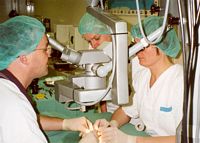


The development of microvascular surgery in Australia
Introduction
Participants
Beginnings
Developing links with academia and hospital medicine
A bevy of supporters
An ever-widening circle of contributors
Building research capacity
Nurturing relationships
Raising funds for research and development
The microsurgeon and the law
Winning community and corporate support
Leadership
The Institute and its style
Endnotes
Index
Search
Help
Contact us

Ann Westmore: How is the relationship with the Hospital nurtured and maintained?
Wayne Morrison: Others can speak much more about this. From my personal point of view, I've had a very good association with the Hospital. I know there have been some rocky times in terms of competitive seeking for funding and so forth.
Ann Westmore: Are Hospital people represented on your Board and vice-versa?
Wayne Morrison: Yes, the CEO of the Hospital is an essential member of our Board.
Laurence Muir: It's very similar to the Baker/Alfred situation. The presence of the teaching hospital has been vital to the work of the Baker and it works very well.
Wayne Morrison: Where difficulties may arise is when there are many pure scientists in an institute who have no clinical association with the hospital and who work in a kind of isolation from clinical realities. It has less to do with the physical location and more to do with a mental dislocation.
James Angus: A big institute can have a clinical research unit but it may be much smaller than the basic research component.
Sue McKay: [74] St Vincent's supports the research of the Institute indirectly in that many of the staff members working in the [operating] theatres are paid by the Hospital, and 90% of our work is microsurgical work. The Foundation would have to come up with a lot of money if they wanted to pay for all our staff.
Ann Westmore: Has that always been the case?
Sue McKay: Yes, We've always been employed by the Hospital.
Ann Westmore: Are you taking work that has been done in the laboratory into the operating theatre?
Sue McKay: I'm a technician, an assistant. I have no medical qualifications. But we do the research side of it. So when all these Fellows come, they actually come to our department as well as spending time with researchers and with Wayne on the clinical side of it. So in a very big indirect way, the Hospital is putting in, supporting what Mr O’Brien wanted from the very start and the ongoing objectives.

Sue McKay (C) and Liliana Pepe (R) teach operating microscope techniques to visiting Irish Fellow, Dr Kevin Cronin. Used with the permission of the Bernard O’Brien Institute of Microsurgery.
Ken Knight: I think you get a much greater sense of the clinical application of the work you do. For example in prefabrication that Michael was talking about, there are clear examples now of how that is used in patients, adopting techniques developed in the laboratory. Some of the drugs that we used, for example urokinase and tissue plasminogen activator drugs that break down blood clots were used in that classical case of scalp replantation [referred to earlier].[75] We had done experiments in the laboratory beforehand looking at the use of some of those drugs in animal experimental models. That contrasts with research I was doing in the past on arthritis where it was less clear how that research was related to clinical practice.
Michael Hickey: That's fairly unique for people who have a pure science background. An example that comes to mind is a patient called Trevor who had dry eyes. He came in for an operation where a salivary gland was transferred to his eye.[76] I was involved in the research but it’s that aspect [of doing research that rapidly translates into clinical application] that hits home.
Ann Westmore: So would he have come in here to have a look at your laboratory?
Michael Hickey: I think Trevor came in to the Institute as a guest to attend a function. And so, to meet a patient with this problem and to talk to him brought home that it was a real issue we were dealing with.
Ann Westmore: I wonder if the smallness of the Institute relative to some others is a benefit in cementing its relationship with the Hospital, or does the texture of the relationship have more to do with the interaction between individuals?
Jim Angus: As a non-Melbourne person – my background is that I'm from Sydney although I worked here at the Baker - I think everybody from both sides has to work very hard at these relationships, all the time. Nothing is a given. You have to keep bringing them into your confidence, talking to them - communicating, bringing us across to them and them to us, and doing things together. Then, there’s no question. And, if there is, get on the telephone and talk it through. Some Institutes are under enormous pressure because they want to expand and can’t, because of other pressures on their associated hospitals. Just because there’s a pragmatic problem, there’s a clash and there’s a danger that the broader vision is lost. We’re stewards of a great tradition here, a tradition that Melbourne values.
 |
Witness to the History of Australian Medicine |  |
© The University of Melbourne 2005-16
Published by eScholarship Research Centre, using the Web Academic Resource Publisher
http://witness.esrc.unimelb.edu.au/058.html